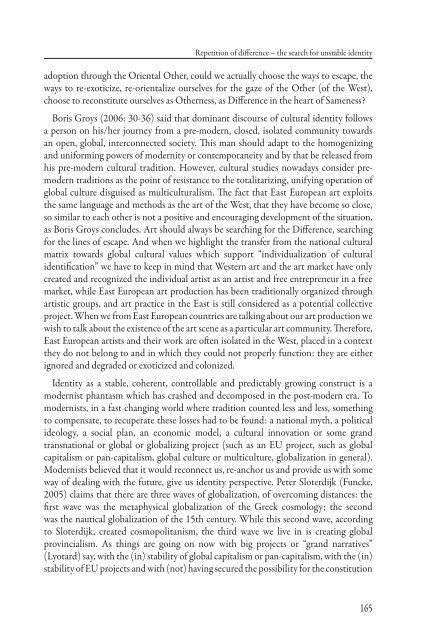Cultural Identity Politics in the (Post-)Transitional Societies
Cultural Identity Politics in the (Post-)Transitional Societies
Cultural Identity Politics in the (Post-)Transitional Societies
Create successful ePaper yourself
Turn your PDF publications into a flip-book with our unique Google optimized e-Paper software.
Repetition of difference – <strong>the</strong> search for unstable identity<br />
adoption through <strong>the</strong> Oriental O<strong>the</strong>r, could we actually choose <strong>the</strong> ways to escape, <strong>the</strong><br />
ways to re-exoticize, re-orientalize ourselves for <strong>the</strong> gaze of <strong>the</strong> O<strong>the</strong>r (of <strong>the</strong> West),<br />
choose to reconstitute ourselves as O<strong>the</strong>rness, as Difference <strong>in</strong> <strong>the</strong> heart of Sameness<br />
Boris Groys (2006: 30-36) said that dom<strong>in</strong>ant discourse of cultural identity follows<br />
a person on his/her journey from a pre-modern, closed, isolated community towards<br />
an open, global, <strong>in</strong>terconnected society. This man should adapt to <strong>the</strong> homogeniz<strong>in</strong>g<br />
and uniform<strong>in</strong>g powers of modernity or contemporaneity and by that be released from<br />
his pre-modern cultural tradition. However, cultural studies nowadays consider premodern<br />
traditions as <strong>the</strong> po<strong>in</strong>t of resistance to <strong>the</strong> totalitariz<strong>in</strong>g, unify<strong>in</strong>g operation of<br />
global culture disguised as multiculturalism. The fact that East European art exploits<br />
<strong>the</strong> same language and methods as <strong>the</strong> art of <strong>the</strong> West, that <strong>the</strong>y have become so close,<br />
so similar to each o<strong>the</strong>r is not a positive and encourag<strong>in</strong>g development of <strong>the</strong> situation,<br />
as Boris Groys concludes. Art should always be search<strong>in</strong>g for <strong>the</strong> Difference, search<strong>in</strong>g<br />
for <strong>the</strong> l<strong>in</strong>es of escape. And when we highlight <strong>the</strong> transfer from <strong>the</strong> national cultural<br />
matrix towards global cultural values which support “<strong>in</strong>dividualization of cultural<br />
identification” we have to keep <strong>in</strong> m<strong>in</strong>d that Western art and <strong>the</strong> art market have only<br />
created and recognized <strong>the</strong> <strong>in</strong>dividual artist as an artist and free entrepreneur <strong>in</strong> a free<br />
market, while East European art production has been traditionally organized through<br />
artistic groups, and art practice <strong>in</strong> <strong>the</strong> East is still considered as a potential collective<br />
project. When we from East European countries are talk<strong>in</strong>g about our art production we<br />
wish to talk about <strong>the</strong> existence of <strong>the</strong> art scene as a particular art community. Therefore,<br />
East European artists and <strong>the</strong>ir work are often isolated <strong>in</strong> <strong>the</strong> West, placed <strong>in</strong> a context<br />
<strong>the</strong>y do not belong to and <strong>in</strong> which <strong>the</strong>y could not properly function: <strong>the</strong>y are ei<strong>the</strong>r<br />
ignored and degraded or exoticized and colonized.<br />
<strong>Identity</strong> as a stable, coherent, controllable and predictably grow<strong>in</strong>g construct is a<br />
modernist phantasm which has crashed and decomposed <strong>in</strong> <strong>the</strong> post-modern era. To<br />
modernists, <strong>in</strong> a fast chang<strong>in</strong>g world where tradition counted less and less, someth<strong>in</strong>g<br />
to compensate, to recuperate <strong>the</strong>se losses had to be found: a national myth, a political<br />
ideology, a social plan, an economic model, a cultural <strong>in</strong>novation or some grand<br />
transnational or global or globaliz<strong>in</strong>g project (such as an EU project, such as global<br />
capitalism or pan-capitalism, global culture or multiculture, globalization <strong>in</strong> general).<br />
Modernists believed that it would reconnect us, re-anchor us and provide us with some<br />
way of deal<strong>in</strong>g with <strong>the</strong> future, give us identity perspective. Peter Sloterdijk (Funcke,<br />
2005) claims that <strong>the</strong>re are three waves of globalization, of overcom<strong>in</strong>g distances: <strong>the</strong><br />
first wave was <strong>the</strong> metaphysical globalization of <strong>the</strong> Greek cosmology; <strong>the</strong> second<br />
was <strong>the</strong> nautical globalization of <strong>the</strong> 15th century. While this second wave, accord<strong>in</strong>g<br />
to Sloterdijk, created cosmopolitanism, <strong>the</strong> third wave we live <strong>in</strong> is creat<strong>in</strong>g global<br />
prov<strong>in</strong>cialism. As th<strong>in</strong>gs are go<strong>in</strong>g on now with big projects or “grand narratives”<br />
(Lyotard) say, with <strong>the</strong> (<strong>in</strong>) stability of global capitalism or pan-capitalism, with <strong>the</strong> (<strong>in</strong>)<br />
stability of EU projects and with (not) hav<strong>in</strong>g secured <strong>the</strong> possibility for <strong>the</strong> constitution<br />
165




